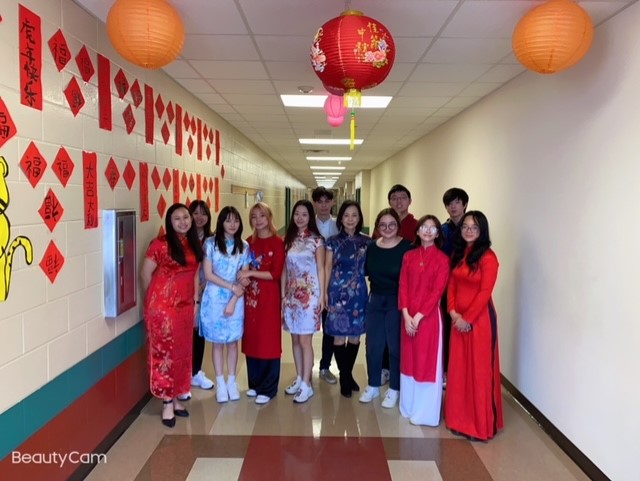A Lunar Celebration
Many students here at GR celebrate Chinese New Year; however, this holiday is discussed very little in school. In honor of the holiday and our celebrating classmates, it is time we delve into the history and traditions and learn about this bustling and bright holiday!
Longhorns in their traditional Lunar New Year wear!
February 14, 2022
Lunar New Year is an Asian Holiday signifying the start of a new year. This holiday, unlike the Gregorian calendar New Year celebration, starts on February 1 and is celebrated for multiple days: 15 in China! Many ethnicities, including Chinese, Korean, and Vietnamese ethnic groups, celebrate Lunar New Year as they look forward to a fresh start.
This week long celebration was traditionally a feasting period to honor ancestors, the gods, and the household, and it starts on the first new moon at the end of January. Hence why it is called Lunar New Year: the celebration starts on a new moon and goes through an entire lunar cycle. The holiday also has traditional zodiac animals, each having a different meaning. This year is Year of the Tiger, signifying strength, bravery, and clearing evil. The 12 zodiac animals cycle through the years; 2021 was Year of the Oxen, and 2020 was Year of the Rat. These occur again years later. According to the Chinese mythology, the zodiacs were chosen by a race across a river. Chinese Jade Emperor told the animals the first 12 to win the race, or cross the rapid river, will get a zodiac named after them. Thus, the zodiacs, and a measurement of the time or Lunar New Year, were assigned and created.
There are many traditional practices in place for the Lunar New Year celebration. In China, on the last day of Lunar New Year, there is a Spring Lantern Festival, or Yuan Xiao, celebrating reunion of families and many spiritual traditions. In Vietnam, the week-long Tết Nguyên Đán is celebrated, and Korea celebrate Seollal for three days. Each celebration allows for the practice of tradition and the eating of many foods such as Chinese dumplings representing the sending away of old times and welcoming of new times; Vietnamese banh chung, a stinky rice cake symbolizing gratitude; and Korean tteokguk, a rice cake soup that is believed to help extend one’s life by another year. These and more traditional foods are prepared and eaten not only on these celebrations but also on Lunar New Year’s Eve.
In addition, many people also celebrate by dressing in traditional clothes, from as simple as red and brightly colored attire to the full on traditional Chinese Tang suit and Qipao or Vietnamese áo dài. However, there are also specific don’ts for one’s clothes of the occasion; wearing black or damaged clothes are two big taboos when considering Lunar New Year dress, as they are considered to be things that bring bad luck.
Lunar New Year also has its own set of traditional activities including the Chinese’s writing couplet, or calligraphy, lantern making, and previously mentioned dumpling making. These activities all have a traditional meaning behind them. For example, writing couplets is thought to bring about one’s wishes for the new year, and lantern making wards off the Nian monster, a fierce beast that eats animals and people. Often, there is also a big dance number performed by people in a life-sized dragon puppet. The dance is seen by the Chinese culture to bring good luck to people.
As the holiday comes to an end this Wednesday, the 16, everyone at the Wrangler wishes you all a happy Lunar New Year and happy Year of the Tiger!





